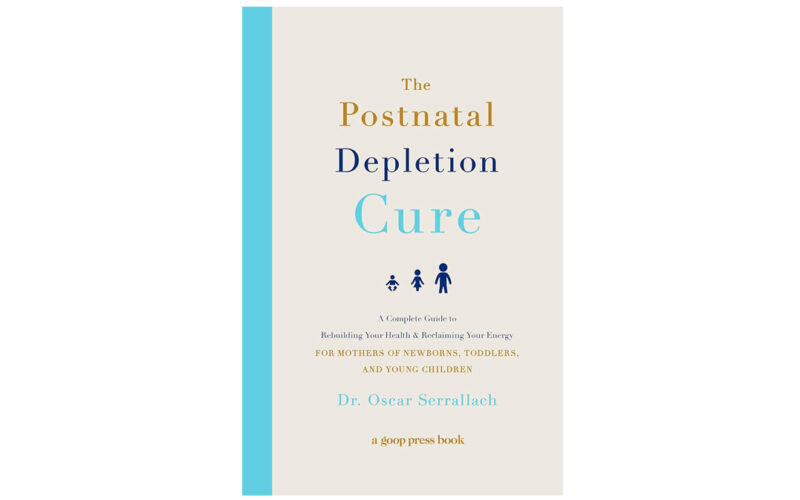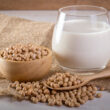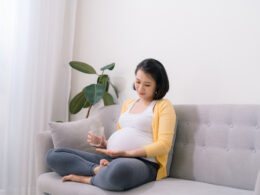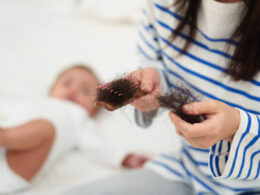It’s no secret that postpartum is a uniquely challenging time. You just completed one of the most physically demanding tasks a woman can go through, the exhaustion from lack of sleep has probably set in, and—if you’re breastfeeding—you’re continuing to physically nurture your baby. For many women, this time is also marked by a lack of social support and emotional dysregulation from their world being turned upside down.
Sometimes, this fatigue and overwhelm can last months or even years after having the baby. Rather than merely chalking it up to the difficulty of motherhood, functional medicine doctor Dr. Oscar Serrallach has another theory: women are both physically and emotionally depleted from the act of growing and birthing a child, which can last far into the postpartum season. In his book, The Postnatal Depletion Cure, Dr. Serrallach gives readers a look into what may be causing their postnatal depletion and (more importantly) how to fix it.
Dr. Oscar Serrallach is a functional medicine doctor from Australia, where he works at an integrative health clinic helping mothers who have suffered from what he calls “postnatal depletion.” Serrallach’s focus on the postpartum mom also extends to his organization The MotherCare Project, which provides resources for both mothers and medical professionals who care for postpartum women.
Who is the intended audience of The Postnatal Depletion Cure?
“I have written this book to answer a question many women ask: ‘How do I get my life and myself back after becoming a mother?’” are the opening words of The Postnatal Depletion Cure. Serrallach describes how both medical providers and society as a whole operate on an “infant-centered” approach, focusing only on the needs of the baby post-birth and ignoring the transformation that the mother has undergone.
This lack of attention on caring for mothers (plus the struggles that his own wife went through after birthing their three children) led Serrallach to explore the struggle women often have after having a baby. Serrallach uses the term postnatal depletion to describe the “constellation of symptoms affecting all spheres of a mother’s life after she has given birth. . . [arising] from physiological issues, hormonal changes, and the interruption of the circadian day/night rhythm of her sleep cycle” (Serrallach, 4).
This intense mixture of change and physical depletion due to the toll that pregnancy, birth, and breastfeeding take on the body can all add up to a woman feeling completely depleted both mentally and physically. The Postnatal Depletion Cure was especially written for postpartum women who are feeling particular symptoms like fatigue, hyper-vigilance, frustration, overwhelm, or “baby brain.” Whether it’s been one month, one year, or even ten years since you’ve had a baby, Dr. Serrallach argues that postnatal depletion could be affecting you.
What are the main content areas of The Postnatal Depletion Cure?
The Postnatal Depletion Cure opens with an exploration into what exactly postnatal depletion is, by first describing what physically occurs during pregnancy and postpartum to make a woman depleted. Serrallach explains how the nutrient stores in a mother’s body are largely given over to the developing baby during pregnancy and used to create breast milk after birth, meaning the mother’s own body often lacks many of these crucial nutrients. He also discusses how “baby brain” is a real thing—caused by brain reprogramming triggered by the placenta, lack of nutrients, stress response, and (of course) sleep deprivation.
Action steps: 100 days of repletion
After postnatal depletion has been defined, Serrallach then gives his “one hundred days of repletion,” which are five jam-packed chapters on physical restoration in the postpartum phase. Topics include rebuilding micronutrients, macronutrients, hormones, energy, and sleep. The chapter on rebuilding micronutrients includes in-depth looks at various vitamins and minerals and give supplement recommendations along the way, and the chapters on rebuilding energy and sleep cover a wide variety of both mainstream and alternative medicine practices.
Food and exercise recommendations
The next two chapters cover Serrallach’s optimal food plan and his optimal exercise plan. The principles laid out in the nutrition chapter are Paleo-inspired (pg. 147) and focus largely on high levels of healthy fats, moderate levels of protein, and low levels of carbohydrates (pg. 148). Dr. Serrallach gives a number of meal plan recommendations and recipes, all of them using only whole foods. His recommendations are similar to those of Lily Nichols, RD in her books Real Food for Fertility and Real Food for Pregnancy, but he generally places a higher emphasis on plant foods rather than the higher animal protein approach that Nichols employs.
His recommendations are similar to those of Lily Nichols, RD in her books Real Food for Fertility and Real Food for Pregnancy, but he generally places a higher emphasis on plant foods rather than the higher animal protein approach that Nichols employs.
Serrallach then delves into exercise, discussing not only why exercise is important for the postpartum woman but also what kinds of exercise are most beneficial. This chapter includes lists of gentle exercises that are targeted at pelvic floor recovery, with detailed instructions on how women can incorporate pelvic floor healing into their daily routines.
Regaining your sense of self
Finally, Serrallach includes a section on “recovering your life,” which includes discussion on emotional well-being, self-care after having a baby, and relationship and libido issues. These chapters are less in-depth, but they do cover topics that are often top of mind for new moms: Why do I not feel like myself anymore? Why has my marriage or relationship changed? How do I make time for the things that I love?
What are the strengths of The Postnatal Depletion Cure?
The core message of The Postnatal Depletion Cure is that while it is common to feel depleted both mentally and physically after birth, there are solutions. Dr. Serrallach does a fantastic job of walking the reader through these myriad solutions, touching on food, exercise, relationships, supplements, sleep, and much more.
A standout chapter, in my opinion, was the long section devoted to the optimal exercise plan for postpartum women. Here, Serrallach not only gives the typical advice of waiting until after 6 weeks to exercise and then slowly re-incorporating movement throughout your day, but he actually gives detailed descriptions of what that exercise could look like. There are over a dozen core-focused exercises described in the book, which are largely similar to what a pelvic floor therapist might recommend you follow. Serrallach also includes specific stretches for relaxation or posture, and gives fantastic guidance to the woman struggling with diastasis recti (the separation of the abdominal muscles after pregnancy) or urinary incontinence.
There are also some interesting sections on traditional Chinese and Indian medicine in the chapter on rebuilding energy, which can give the reader some additional ideas on alternative modes of healing. He discusses how acupuncture and the use of traditional Chinese herbs can be beneficial in speeding up repletion times, as well as how the usage of Ayurveda—an Indian medicinal tradition—uses herbal tonics and warming foods to promote peace and recovery. These ideas are given briefly, with recommendations on how readers can learn more if they’re interested. Serrallach presents these, along with certain breathing exercises, as other ways to regain energy after improving your sleep and exercise regimen.
The Postnatal Depletion Cure’s limitations or blindspots
The most obvious blindspot to The Postnatal Depletion Cure is that the author is someone who has never been through pregnancy or postpartum personally—since he is a man! However, Dr. Serrallach has been through it as a supportive husband and also a doctor helping women walk through the difficulties of postpartum life. His recommendations, while not personal in nature, are honest and kind. Women who read The Postnatal Depletion Cure would also benefit from talking to other women in their life who have been through the postpartum season previously to get some of their advice in addition to the recommendations of Serrallach.
Another limitation of the book is that Serrallach does not delve into what to do if you are postnatally depleted but also looking to continue having more children in the future. His plan is more of a short- to medium-term fix for those looking to feel better after having a child, but he doesn’t discuss the fact that the rhythmic nature of a woman’s fertile years can mean that she might be having to replete and then become depleted again multiple times over. I’d highly recommend checking out Real Food for Fertility for mothers looking to become pregnant again in the future, as the authors discuss how women can prepare themselves for a future pregnancy.
The verdict: To buy, borrow, or skip The Postnatal Depletion Cure?
If you’re in a postpartum season and struggling with low energy or any of the other postnatal depletion symptoms described above, I’d recommend buying The Postnatal Depletion Cure. It is an all-encompassing look at what you can do to help you feel more like yourself after giving birth, and there are great specifics on topics like exercise and supplements. However, women dealing with postpartum depression or serious levels of energy depletion should also seek professional help. If you’re multiple years postpartum and still feeling exhausted and on edge from motherhood, I’d recommend at least borrowing The Postnatal Depletion Cure. You’re worth the time and effort it takes to feel well and whole, and Serrallach’s recommendations could be a great way to start your journey back to feeling good again.










